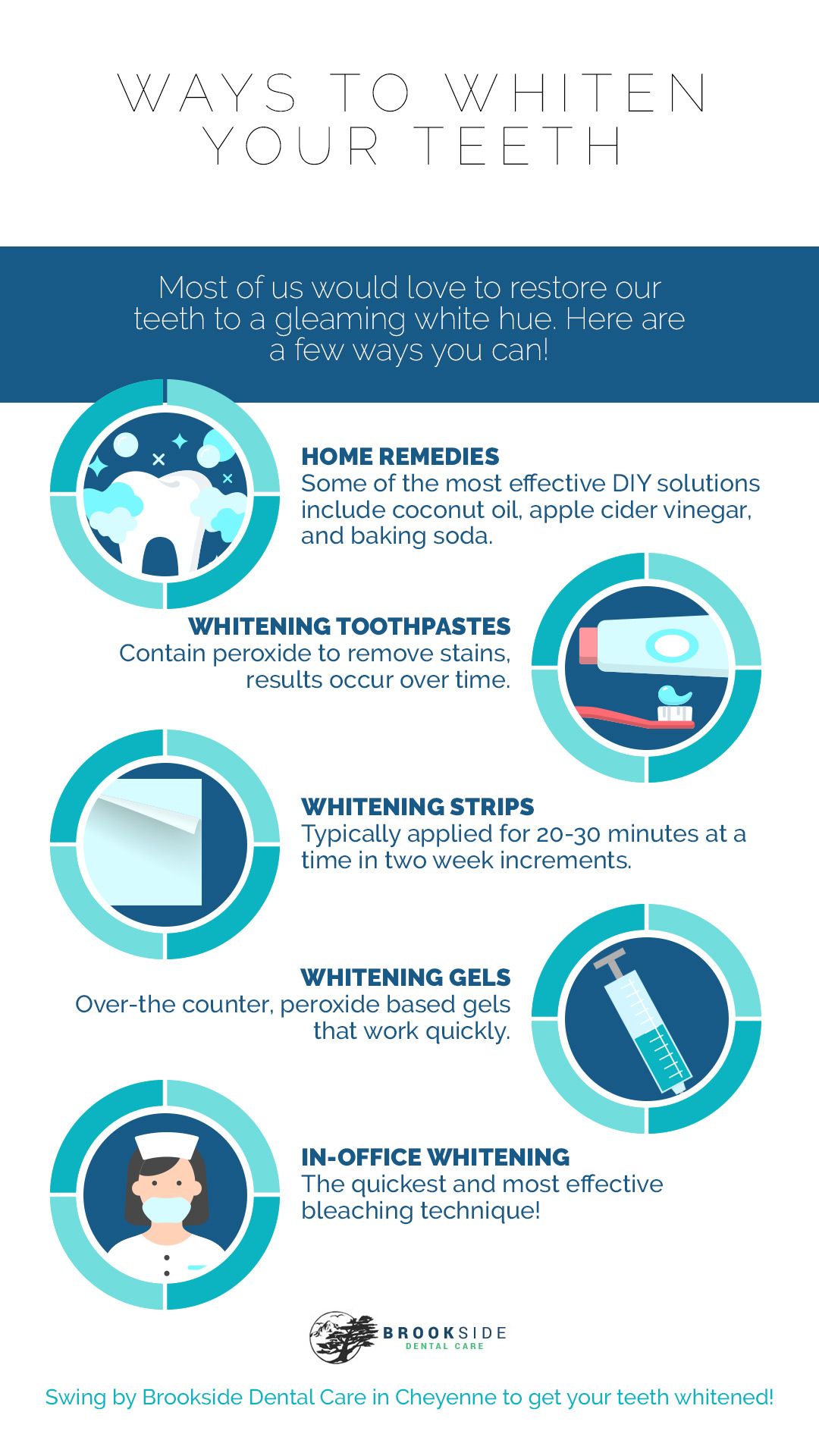Everyone can appreciate a clean, white smile. While we might not immediately notice it, our teeth will lose their coloration over time and take on a brown or yellowish tint. There are different cosmetic dentistry techniques that can be used to actively fight and prevent this to keep your smile up to your gleaming standards!

How To Whiten Your Teeth
What Causes Discoloration?
Teeth begin turning yellow when the enamel on the surface of the teeth begins to develop stains, or stains develop deep within the tooth. Every human tooth has a brown substance called dentin which sits underneath the enamel. When the enamel begins to thin, this brown color can begin to show through. Common risks for enamel thinning include aging and genetics, as well as eating and drinking certain things.
Drinking coffee or tea is one main cause of teeth turning yellow. Soda and wine are also drinks that can get into the enamel of your teeth and begin to thin it over time. Processed foods and candy should also be avoided due to their high acidity which breaks down tooth enamel. That being said, not drinking enough water can lead to a dry mouth, which means less saliva to protect the enamel of your teeth. For white teeth, it is important to consume a healthy diet balanced by lots of water.
Cigarette smokers also put themselves at a higher risk of losing the white shine to their teeth. The tar and nicotine in cigarettes have been proven to stain the surface of your teeth, and can also lead to more extreme dental issues such as gum disease and tooth decay.
Home Remedies
If you are serious about restoring a healthy white coloration to your teeth, we recommend pursuing professional treatment or spending the extra cash on clinically tested products. However, there are some natural home remedies that you can try if you are looking for a quick fix.
Coconut Oil
Yes, it does seem like coconut oil is included in blogs of how to fix just about anything these days, but many people praise coconut oil for its teeth cleaning and whitening capabilities. In order to clean with coconut oil, take a teaspoon and swish it around your mouth for at least several minutes. Coconut oil works by removing some of the bacteria from your mouth which could lead to teeth stains. If you are a fan of the taste of coconut, give this technique a try!
Apple Cider Vinegar
Like coconut oil, ASV works by killing the harmful bacteria in your mouth and promoting healthy bacteria. Its natural acidity helps remove plaque from the surface of your teeth, and in many cases will lead to noticeable results in a short time frame.
Because of the acetic acid in vinegar, apple cider vinegar should not be used too often as a teeth whitening agent, as it has the ability to wear down the enamel of your teeth over time. If you want to use it as a mouthwash, consider watering it down first.
Baking Soda
Baking soda is also a mild abrasive that can help eliminate stains. There are many recipes online that can show you how to make your own baking soda paste to scrub your teeth with, but we recommend just using toothpaste with sodium bicarbonate if this is your goal. While it is not a quick fix, it has been proven that baking soda will work away at those stains over time.
Prevent Stains Before They Happen
There is a reason that dentists harp on brushing twice a day and flossing as often as possible. Not only is this an essential part in promoting healthy gums and strong teeth over the years, it also actively fights the buildup of plaque that leads to tooth discoloration. Fighting the build-up of plaque and avoiding foods that promote unhealthy bacteria such as sugars, coffee, and soda are simple things you can incorporate into your everyday life to keep your teeth looking naturally white!
Whitening Toothpastes
All kinds of toothpaste could be considered “whitening toothpaste” because they all contain mild abrasives that help remove stains. Tubes of toothpaste that are marketed as whitening toothpaste typically contain peroxide that helps eliminate stains. Blue covarine is a common chemical found in these pastes, and it sticks to the surface of the teeth in a thin coat to make them appear whiter. When looking for whitening toothpaste, look for a brand that has a seal of approval, such as the American Dental Association Seal of Acceptance. Whitening kinds of toothpaste are a cheaper alternative and easy tool that you can work into your everyday routine, but will not work as fast as other techniques.
Whitening Strips and Gels
Strips do an excellent job of removing stains from teeth. Strips contain bleach and work in the same way that bleach works to whiten your clothes. Strips are applied evenly across the enamel of your teeth and typically left on for 20-30 minutes. Using whitening strips daily for as little as one week can lead to visible results. If you have an important date or event that you are trying to look your best for, strips are a fast working option. One of the most popular options are the Crest 3D White Strips.
Gels are another good option for adults. These products are clear, peroxide-based gels that are applied to the surface of your teeth like toothpaste. Similar to gels, these are applied once or twice a day for roughly two weeks. When purchasing strips or gels, be prepared to spend thirty-to-fifty dollars for a product that will be used up within two weeks. That being said, these products work faster than any toothpaste or home remedy and can last up to several months.
Whitening Rinses
Rinses are one of the newest products to hit the market and differ from your typical mouthwash. They contain hydrogen peroxide, which helps kill bacteria in your mouth and eliminate plaque. Rinses are not as effective as strips or gels merely because they are not in contact with your teeth for as long. Rinses are only used in increments of 30-60 seconds per day, as opposed to the thirty minutes that you can have a whitening strip on.
In-Office Whitening
Bleaching with a professional dental clinic is the quickest way to whiten teeth. A treatment lasting under two hours can leave you with immediate, visible effects. It is no surprise that this is also a more expensive approach depending on what your insurance will cover. We offer in-house whitening at our Cheyenne location, where we use a combination of gel application and a special light. For the best results, multiple visits are recommended.
An Ongoing Process
At most, the effects of teeth whitening will last several months. No matter how bad you want those pearly whites, it is inevitable that you will want to drink coffee or tea, eat sugar, or fall off of your brushing and flossing routine from time to time. Teeth whitening is not permanent! If you want to maintain a polished smile, it will take discipline and repeat treatments, whether that be whitening strips, in-office treatments, or a different method.
Contact Brookside Dental Care
If you are interested in further advice on how you can maintain your dream smile, give us a call at Brookside Dental to schedule your next appointment or learn about specific options for in-house teeth whitening techniques. We are proud to serve the city of Cheyenne and the surrounding Wyoming community by improving their dental health and giving them smiles they can be confident about!

